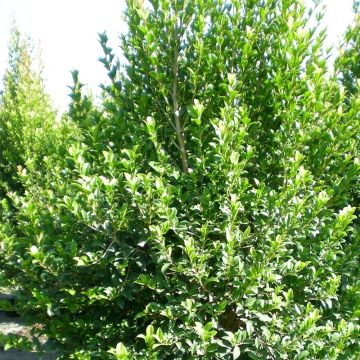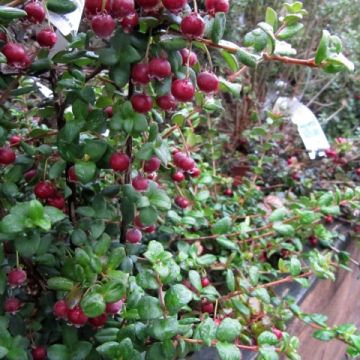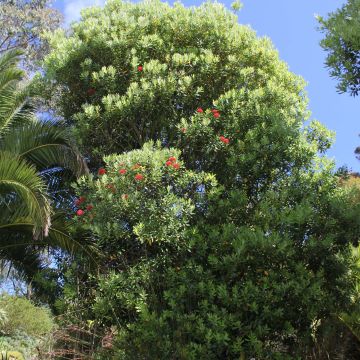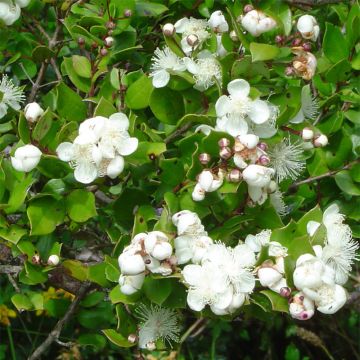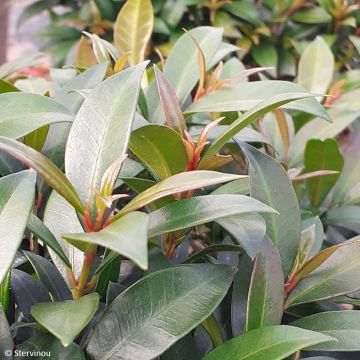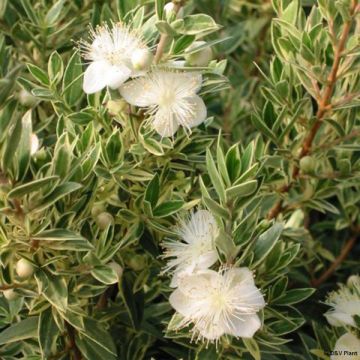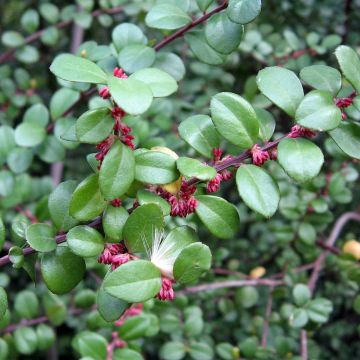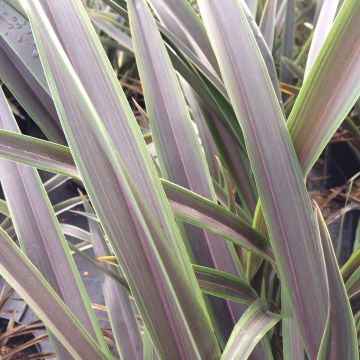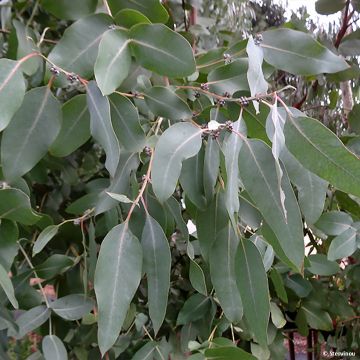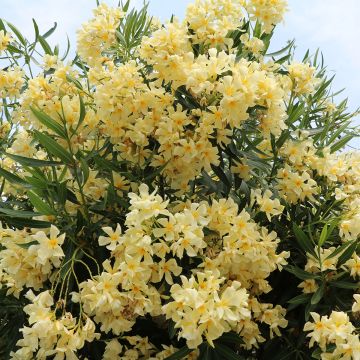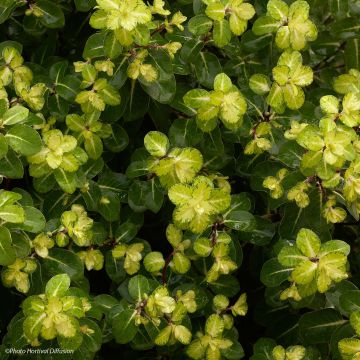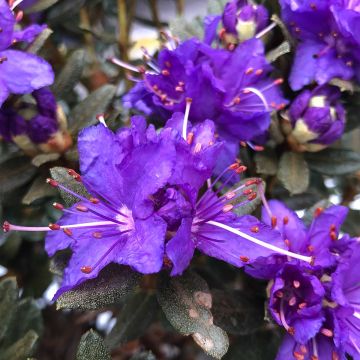

Myrtus communis subsp. tarentina
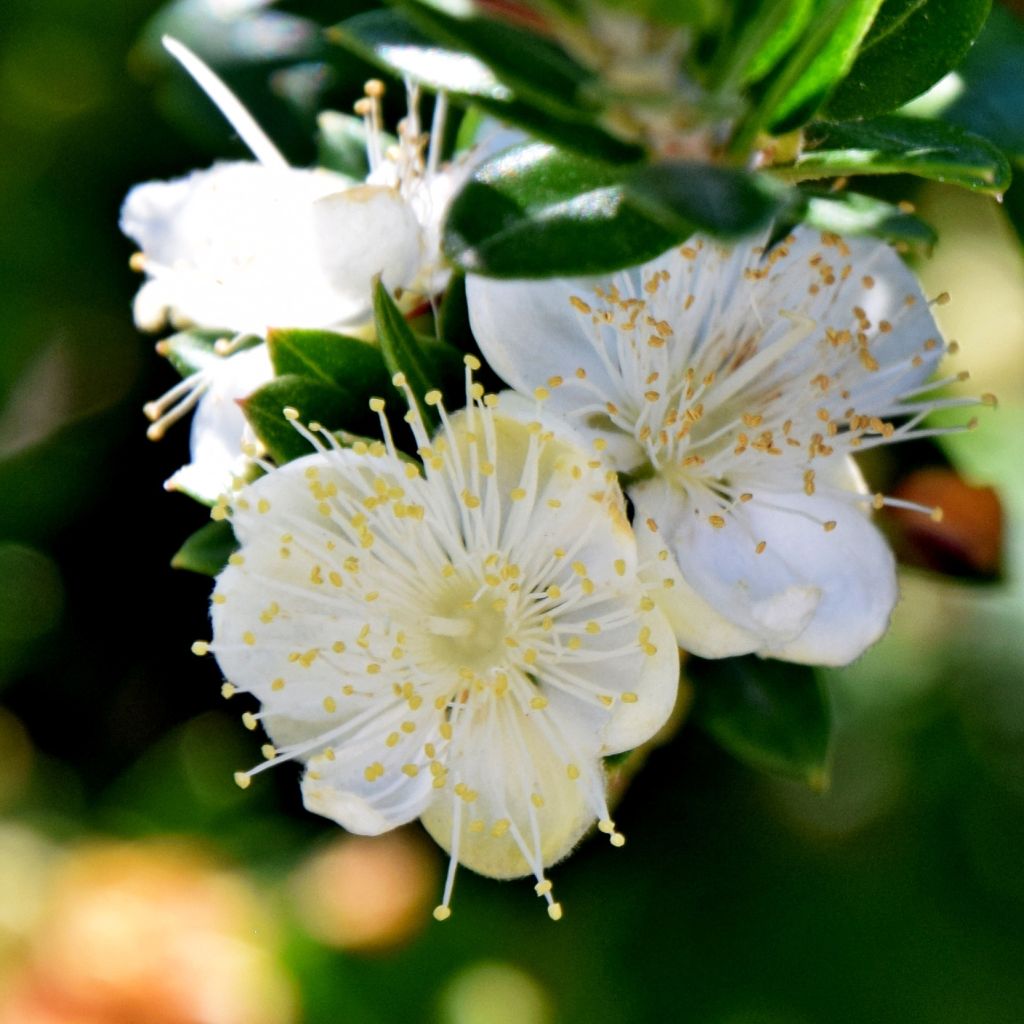

Myrtus communis subsp. tarentina
View more pictures
Hide images

Liliia B.

Myrtus communis Tarentina during its first year
Liliia B. • 59 FR
Myrtus communis subsp. tarentina
Myrtus communis subsp.tarentina
Tarentum Myrtle, Taranto Myrtle
Small and vigorous plant, I can't wait for the flowering! ????
Momo, 21/05/2025
Special offer!
Receive a €20 voucher for any order over €90 (excluding delivery costs, credit notes, and plastic-free options)!
1- Add your favorite plants to your cart.
2- Once you have reached €90, confirm your order (you can even choose the delivery date!).
3- As soon as your order is shipped, you will receive an email containing your voucher code, valid for 3 months (90 days).
Your voucher is unique and can only be used once, for any order with a minimum value of €20, excluding delivery costs.
Can be combined with other current offers, non-divisible and non-refundable.
Home or relay delivery (depending on size and destination)
Schedule delivery date,
and select date in basket
This plant carries a 24 months recovery warranty
More information
We guarantee the quality of our plants for a full growing cycle, and will replace at our expense any plant that fails to recover under normal climatic and planting conditions.


Would this plant suit my garden?
Set up your Plantfit profile →
Description
Myrtus communis subsp. tarentina is a subspecies of the common myrtle, particularly interesting for its ease of cultivation. It can be grown in all regions where winter temperatures do not exceed -12°C (10.4°F). This evergreen bush, surrounded by a mystical fragrance and a strong symbolic significance, shares a long history with the peoples of the Mediterranean basin. With its small, tough, dark green foliage densely packed on its branches, it blooms in the heart of summer, punctuating its vegetation with a multitude of small, white, fragrant flowers with prominent stamens, sparkling on its dense and dark mass, light as snowflakes. Relatively hardy in well-drained soil and not demanding on the nature of the soil, this variety is essential in a dry garden, in the sun as well as in the shade!
Myrtus communis subsp. tarentina, also known as Tarentum myrtle, belongs to the Myrtaceae family. It is found in the wild at the edge of oak or pine forests, in scrub vegetation and rocky maquis of the Mediterranean region, up to Lebanon. It is a slow-growing bush with a naturally dense and compact habit. It will reach 1.5 to 2m (5 to 7ft) in height, sometimes more, with a diameter of 1 to 1.5m (3 to 5ft). The evergreen leaves are ovate with a pointed tip and remarkably aromatic. They are used to extract an essential oil widely used in perfumery and aromatherapy. They measure no more than 1cm (1in) in length and 0.5cm (1in) in width. They are shiny on both sides, and have a very pronounced central vein. The bush blooms generously from July to September, which is surprising for a plant in a dry climate. The small, white, solitary flowers with 5 petals, 1cm (1in) wide, open on a large cluster of prominent stamens; they appear in the axils of the leaves, on the current year's shoots. They are followed by the formation of small, pruinose, ovoid and fleshy fruits in autumn. The fruits are black-blue or sometimes white, and are used in cooking or for making liqueurs.
Brighter and finer than boxwood, disease-free, adorned with a thousand adorable little flowers in summer, and fragrant, Myrtus tarentina would undoubtedly be more widely used in small trimmed or informal hedges, and in topiary art if it were a little hardier. It adapts to all exposures, tolerates both acidic and slightly calcareous soils, and requires no special care once well established. The myrtle tolerates pruning very well, in April or October, which does not affect its flowering. If its vegetation is damaged by a severe winter, it is capable of regrowing from the stump. It can be planted with dwarf pomegranates or flowering pomegranates, agapanthus, arborescent wormwoods, and shrubby salvias (microphylla), in a colourful checkerboard or a small Mediterranean-inspired bed. It is easily grown in a large container, for example, accompanying a four seasons mimosa, and withstands sea spray well. At the edge of a grove or woodland, it can be planted alongside Mexican orange blossom, laurel-leaved rockrose (a hardy rockrose to -15°C (5°F)), blood twig dogwood, or European spindle 'Red Cascade'.
Report an error about the product description
Myrtus communis subsp. tarentina in pictures
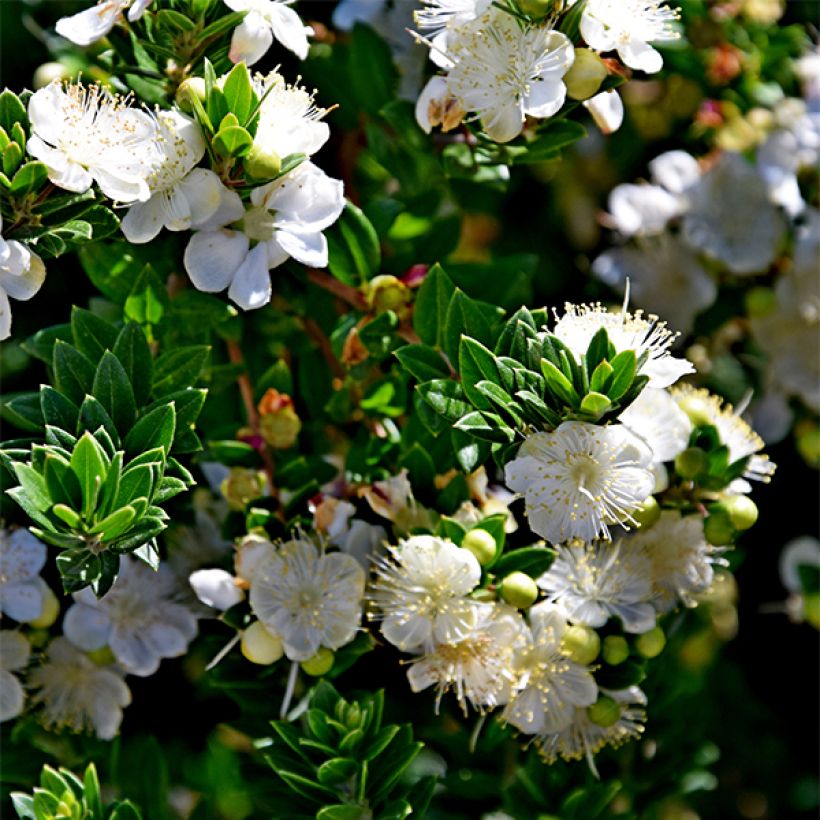

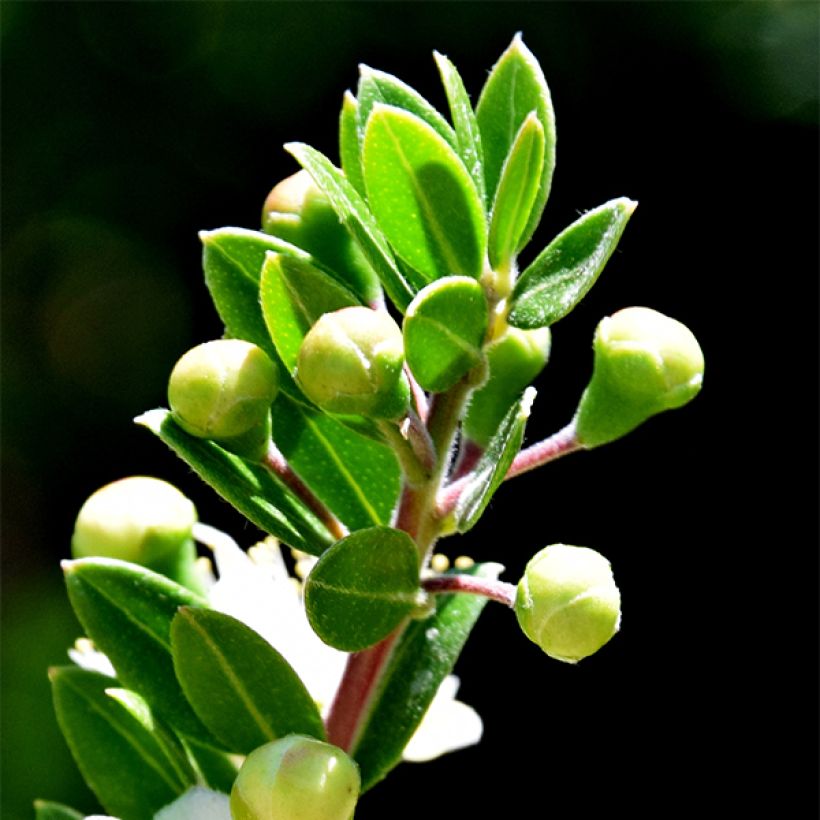

Plant habit
Flowering
Foliage
Botanical data
Myrtus
communis subsp.tarentina
Myrtaceae
Tarentum Myrtle, Taranto Myrtle
Mediterranean
Other Myrtus - Myrtle
View all →Planting and care
It requires light, well-drained, and not too fertile, even poor, soil. A perfectly drained soil, whether rocky or sandy, slightly acidic, neutral, or even slightly alkaline will do. Plant it after the last frost in cool regions, and in September-October in hot and dry climates. It will thrive in the sun, partial shade, or even shade in hot climates, and likes to have warm roots. Under these conditions, it is hardy to -10 or -12°C (14 or 10.4°F), and can live for more than a century. Mulch it in winter in the coldest regions, and protect it from the cold as much as possible. Place it in the warmest corner of the garden, in full sun against a south-facing wall, in a rocky or sandy slope, in any substrate that does not retain moisture, which would be fatal to it in winter. To shape it, you can prune the stems in March-April or after flowering to encourage the plant to branch out.
Cultivation in pots:
Provide good drainage at the bottom of a large pot. Use a lightweight substrate, enriched with leaf compost, and apply a slow-release fertiliser in late winter and autumn. Water generously in summer, while allowing the potting soil to dry between waterings. The more you water, the more your myrtle will bloom.
Planting period
Intended location
Care
-
, onOrder confirmed
Reply from on Promesse de fleurs
Similar products
Haven't found what you were looking for?
Hardiness is the lowest winter temperature a plant can endure without suffering serious damage or even dying. However, hardiness is affected by location (a sheltered area, such as a patio), protection (winter cover) and soil type (hardiness is improved by well-drained soil).

Photo Sharing Terms & Conditions
In order to encourage gardeners to interact and share their experiences, Promesse de fleurs offers various media enabling content to be uploaded onto its Site - in particular via the ‘Photo sharing’ module.
The User agrees to refrain from:
- Posting any content that is illegal, prejudicial, insulting, racist, inciteful to hatred, revisionist, contrary to public decency, that infringes on privacy or on the privacy rights of third parties, in particular the publicity rights of persons and goods, intellectual property rights, or the right to privacy.
- Submitting content on behalf of a third party;
- Impersonate the identity of a third party and/or publish any personal information about a third party;
In general, the User undertakes to refrain from any unethical behaviour.
All Content (in particular text, comments, files, images, photos, videos, creative works, etc.), which may be subject to property or intellectual property rights, image or other private rights, shall remain the property of the User, subject to the limited rights granted by the terms of the licence granted by Promesse de fleurs as stated below. Users are at liberty to publish or not to publish such Content on the Site, notably via the ‘Photo Sharing’ facility, and accept that this Content shall be made public and freely accessible, notably on the Internet.
Users further acknowledge, undertake to have ,and guarantee that they hold all necessary rights and permissions to publish such material on the Site, in particular with regard to the legislation in force pertaining to any privacy, property, intellectual property, image, or contractual rights, or rights of any other nature. By publishing such Content on the Site, Users acknowledge accepting full liability as publishers of the Content within the meaning of the law, and grant Promesse de fleurs, free of charge, an inclusive, worldwide licence for the said Content for the entire duration of its publication, including all reproduction, representation, up/downloading, displaying, performing, transmission, and storage rights.
Users also grant permission for their name to be linked to the Content and accept that this link may not always be made available.
By engaging in posting material, Users consent to their Content becoming automatically accessible on the Internet, in particular on other sites and/or blogs and/or web pages of the Promesse de fleurs site, including in particular social pages and the Promesse de fleurs catalogue.
Users may secure the removal of entrusted content free of charge by issuing a simple request via our contact form.
The flowering period indicated on our website applies to countries and regions located in USDA zone 8 (France, the United Kingdom, Ireland, the Netherlands, etc.)
It will vary according to where you live:
- In zones 9 to 10 (Italy, Spain, Greece, etc.), flowering will occur about 2 to 4 weeks earlier.
- In zones 6 to 7 (Germany, Poland, Slovenia, and lower mountainous regions), flowering will be delayed by 2 to 3 weeks.
- In zone 5 (Central Europe, Scandinavia), blooming will be delayed by 3 to 5 weeks.
In temperate climates, pruning of spring-flowering shrubs (forsythia, spireas, etc.) should be done just after flowering.
Pruning of summer-flowering shrubs (Indian Lilac, Perovskia, etc.) can be done in winter or spring.
In cold regions as well as with frost-sensitive plants, avoid pruning too early when severe frosts may still occur.
The planting period indicated on our website applies to countries and regions located in USDA zone 8 (France, United Kingdom, Ireland, Netherlands).
It will vary according to where you live:
- In Mediterranean zones (Marseille, Madrid, Milan, etc.), autumn and winter are the best planting periods.
- In continental zones (Strasbourg, Munich, Vienna, etc.), delay planting by 2 to 3 weeks in spring and bring it forward by 2 to 4 weeks in autumn.
- In mountainous regions (the Alps, Pyrenees, Carpathians, etc.), it is best to plant in late spring (May-June) or late summer (August-September).
The harvesting period indicated on our website applies to countries and regions in USDA zone 8 (France, England, Ireland, the Netherlands).
In colder areas (Scandinavia, Poland, Austria...) fruit and vegetable harvests are likely to be delayed by 3-4 weeks.
In warmer areas (Italy, Spain, Greece, etc.), harvesting will probably take place earlier, depending on weather conditions.
The sowing periods indicated on our website apply to countries and regions within USDA Zone 8 (France, UK, Ireland, Netherlands).
In colder areas (Scandinavia, Poland, Austria...), delay any outdoor sowing by 3-4 weeks, or sow under glass.
In warmer climes (Italy, Spain, Greece, etc.), bring outdoor sowing forward by a few weeks.






























